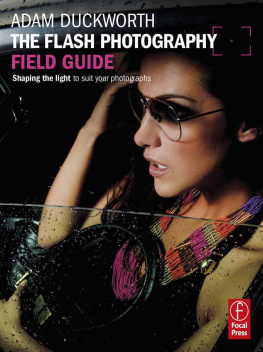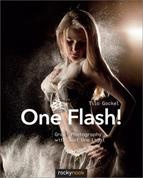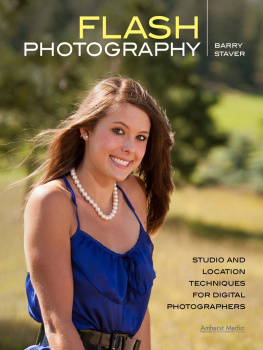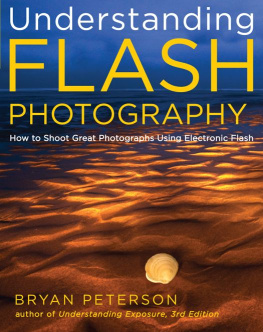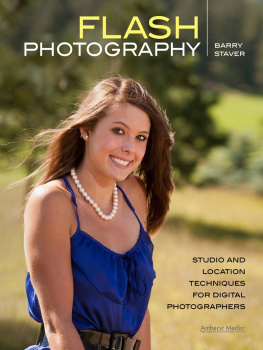
ADAM DUCKWORTH
THE FLASH PHOTOGRAPHY FIELD GUIDE

ADAM DUCKWORTH
THE FLASH PHOTOGRAPHY FIELD GUIDE
Shaping the light to suit your photographs
Focal Press is an imprint of Elsevier Inc.
225 Wyman Street, Waltham
MA 02451, USA
Copyright 2012 The Ilex Press Ltd.
All rights reserved
This book was conceived, designed, and produced by Ilex Press Limited
210 High Street, Lewes, BN7 2NS, UK
Publisher: Alastair Campbell
Associate Publisher: Adam Juniper
Creative Director: James Hollywell
Managing Editor: Natalia Price-Cabrera
Editor: Tara Gallagher
Specialist Editor: Frank Gallaugher
Senior Designer: Kate Haynes
Designer: Jon Allan
Illustrator: John Woodcock
Color Origination: Ivy Press Reprographics
No part of this publication may be reproduced, stored in a retrieval system or transmitted in any form or by any means electronic, mechanical, photocopying, recording or otherwise without the prior written permission of the publisher.
Permissions may be sought directly from Elseviers Science & Technology Rights Department in Oxford, UK: Phone (+44) (0) 1865 843830; Fax (+44) (0) 1865 853333; Email: permissions@elsevier.com. Alternatively visit the Science and Technology Books website at www.elsevierdirect.com/rights for further information.
Notice: No responsibility is assumed by the publisher for any injury and/or damage to persons or property as a matter of products liability, negligence or otherwise, or from any use or operation of any methods, products, instructions or ideas contained in the material herein.
Trademarks/Registered Trademarks: Brand names mentioned in this book are protected by their respective trademarks and are acknowledged.
Library of Congress Control Number:
A catalog record for this book is available from the Library of Congress.
ISBN: 978-0-240-82424-6
For information on all Focal Press publications visit our website at:
www.focalpress.com
Printed and bound in China
10 11 12 13 14 5 4 3 2 1
CONTENTS
All committed photographers continually ask themselves the question, how can I take better pictures? Well, there are two steps. The first step is to stand in front of something more interesting! This may sound obvious, but its a serious point. More broadly, it means that you need to think about what youre photographing: who the subject is, and what theyre doing, and also to think about the composition, choice of lens, and the viewpoint.

A stunning poolside location and a pretty model are the basis of a potentially good image, but harsh overhead sun ruined the light on the model. A flash, just out of frame to the right, reduces the harsh shadows. Nikon D3X; 35mm focal length; ISO 100; 1/250 sec at /11.
I wish I could take credit for coming up with the phrase stand in front of something interesting, but I borrowed it from another photographer, who admitted to stealing it from another and so it goes on. Now you can pass it off as your own piece of advice!
The second way to improve your shots is to photograph the light. The light can turn your photograph from simply showing what the subject looks like to something far more exciting. Amazing light can turn the most humdrum picture into something interesting, and can transform a good picture into something truly spectacular.
Of course, light is all around us: from natural sunlight, to moonlight, to artificial lights from houses and streetlights. The masters of available-light photography seem to be able to work magic with what is available, using only a few reflectors or diffusers to give it a boost or to manipulate it.
However, when lovely, quality light just isnt there, isnt spectacular, or you arent able to wait for that sunset or sunrise, there is another optionto create and control your own light using flash. If youve only ever used your cameras onboard flash or a flashgun fastened to the hotshoe, then chances are youve had disappointing results. Hard, unflattering shadows, red eye, and a loss of natural atmosphere are regular complaints from photographers who often go to extreme lengths to avoid using strobe power. There is a way to utilize flash properly, however. Taking control of your flash, changing its position relative to the subject, and altering its light output via different modifiers is a great way to achieve amazing, professional-quality results.
Using flash in this way was previously the reserve of the well-kitted professional, armed with years of technical knowledge and experience. Nowadays, however, its far easier and cheaper thanks to built-in wireless triggering systems and a glut of aftermarket accessories. Also, with digital photography you can see the results instantly on your LCD screen, which is a massive aid to getting well-lit images. The Flash Photography Field Guide aims to counsel you in how to effectively use your flashgun, as well as to inspire you with some great images and details of how they were taken.
Whether its coming from your flash, the sun, or the interior lights in a building, all light has certain properties that a clued-in photographer should be aware of. It doesnt matter if youre shooting a lovely landscape, a natural-light portrait, or blasting away with an on-camera flash in a dark nightclub: if you learn to consider the properties of the light, then youre in a great position to understand how the photo will look. Youll also understand how you can alter the light, or introduce your own effectively.

Without a clear understanding of light, youll find it tough to capture natural-looking photos of interiors, for example. Mixed light sourcesfrom daylight, to halogen shop lights, to flashare skillfully combined in this shot. Nikon D3; 14mm focal length; ISO 200; 1/40 sec at /8.
W henever you take a photo, the six key properties of light you should consider are as follows: the quality, direction, contrast, intensity, evenness, and color temperature. You should also bear in mind that if you alter one of those properties by modifying the light in some way, such as by introducing a flash, that these properties will change and affect each other.
That may seem like a lot to have to think about, but the more you do it, the easier and more natural it becomes. Eventually it will feel like second nature and be a real aid in helping you quickly decide what to do with your lighting, such as where to position your flashes, how to modify their output, what color gel you may need, and much more.

